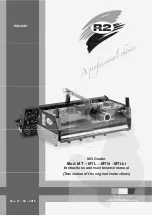
9
1.
Straps, stitching and webbing.
Check entire
length of the strap for excessive wear. Inspect the
tongue or billet end carefully. This end is subject to
considerable wear as a result of repeated buckling
and unbuckling of the belt. Also, check for torn or
excessively enlarged buckle-tongue holes. Check
stitching for broken, cut or pulled stitches. Check
webbing for broken strands, which appear as tufts
on the surface.
2.
D-rings.
Check all D-rings for distortion. Check
D-ring attachment points for unusual wear or dam-
aged fibers. Badly pitted D-rings could indicate
chemical corrosion, and the equipment should be
replaced immediately.
3.
Tongue buckles.
Check tongue buckles for
distortion, sharp edges and cracks. The tongue
should move freely and overlap the frame. Rollers
should not be distorted and should roll freely.
.
Stitching or rivets at hardware attachment
points.
For stitching-attachment points, check that
stitching is not broken, burned, cut or pulled. For riv-
eted attachment points, check all rivets for tightness,
especially those at D-ring wear pads. Badly-pitted
rivets indicate chemical corrosion, and equipment
should be replaced immediately.
5.
Destroy and replace all worn or damaged
OPE equipment.
If any evidence of excessive
wear, deterioration, or mechanical malfunction is
observed, replace equipment immediately.
Never
work with worn or damaged OPE equipment.
Using damaged or worn equipment can cause
serious injury or death.
6.
The inspector is the most important part of any
inspection procedure.
Check all equipment thoroughly
and follow all safety procedures and guidelines.
Do not take any shortcuts.
Important Note:
OSHA specifies that all employers
covered by the Occupational Safety and Health Act
are responsible for inspection and maintenance of all
tools and equipment used by employees — whether
owned by the employees or by the company.
Personal-protective equipment should be inspected
before each use, and immediately removed from
service if any sign of wear or damage is found.
E1
Inspection of Belts & Straps
C1
D1
If you note any unusual conditions dur-
ing the inspection that are not specified here, do
NOT
use the suspect equipment until a qualified
individual has made a decision on its usability.
Содержание KG5295-6-6L
Страница 12: ...12 Notes Notas ...
Страница 24: ...24 Notes Notas ...










































